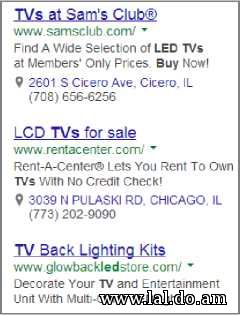Do Your Ads Reflect the Search Query?
Ads serve as a bridge between the search query and your landing page. Your goal is to have enticing ad copy that causes a user to “cross the bridge” from a search result and arrive at your website. AdWords ads do not need to be gimmicky. The ads need to quickly convey to the consumer that the answer to their search can be found on your website. If your ad has enticed someone to cross the bridge, the ad copy has done its job. Of course, it’s not quite that simple. There are many types of bridges. Some ads emphasize conversions, and others focus on clicks. Your job is to build an ad that produces results for your company, based on your company’s goals, by bringing the correct prospects to your website. The ad should reflect both the keywords in your account and the user’s search query. If the ad is not highly relevant to both of those items, it will be less effective (Figure 4.1). Ad copy that does not cover both the search query and your keywords is like a bridge that leads to nowhere. Either your ad leads someone to the answer to their question, or it leads off in an irrelevant direction. Make sure you are always bringing the consumer closer to the answer to their question, assuming the answer is a conversion on your website. Therefore, it is imperative that you go through the exercise of ensuring that your ad copy will be reflective of your keywords and the search query. Since you know your keywords and what type of related queries should trigger them (refer to the search query report in Chapter 16, “AdWords Reports: Extracting Actionable Information”), one of the most important exercises to undertake before writing ads is to ensure you have granular account organization. I will mention this concept several times throughout this book because this organization can determine the effectiveness of your account.
Figure 4.1 For the highly commercial search buy LED TV, these ads do not speak to the user's query.
Granular account organization means that the keywords in an ad group are highly related and you do not see additional ways to separate out the keywords. In addition, your ad copy should reflect every single keyword in your ad group. For example, let’s say your ad group is about HDTVs and contains these keywords:
With these keywords, your ad group is not granular enough. The keywords could be in several different ad groups: one for plasma TVs, one for LED TVs, and so on. First, write an ad with one explicit meaning. Imagine that if someone saw this ad, they could assume you do only this one particular thing, such as you only offer weekend plumbing services, small business accounting solutions, or used books less than $5. Now, look at your keywords. Does the ad copy reflect the keywords? If yes, the keywords are in the correct place. If no, move the keywords to a new ad group. Consider someone who searches for buy plasma tv and sees the two ads shown in Figure 4.2. Which one would you click? While a plasma TV is a hi-def TV, there are other types of hi-def TVs, such as LED or LCD. The use of the word buy in the query informs us that this is a commercial query with high purchase intent. This searcher is not likely to change their TV choice from a plasma TV. Therefore, you would want to show this searcher a plasma TV ad. The exercise of breaking down your ad groups into specific keyword and ad copy combinations will take a while, but it will assist greatly in ad copy writing. Because you now only have to reflect one specific theme in your ad copy, you only need to write ads for one explicit meaning.
© Advanced Google Adwords: 3rd edition >>> Back to TABLE OF CONTENTS <<< | |
| Views: 465 | |
| Total comments: 0 | |

